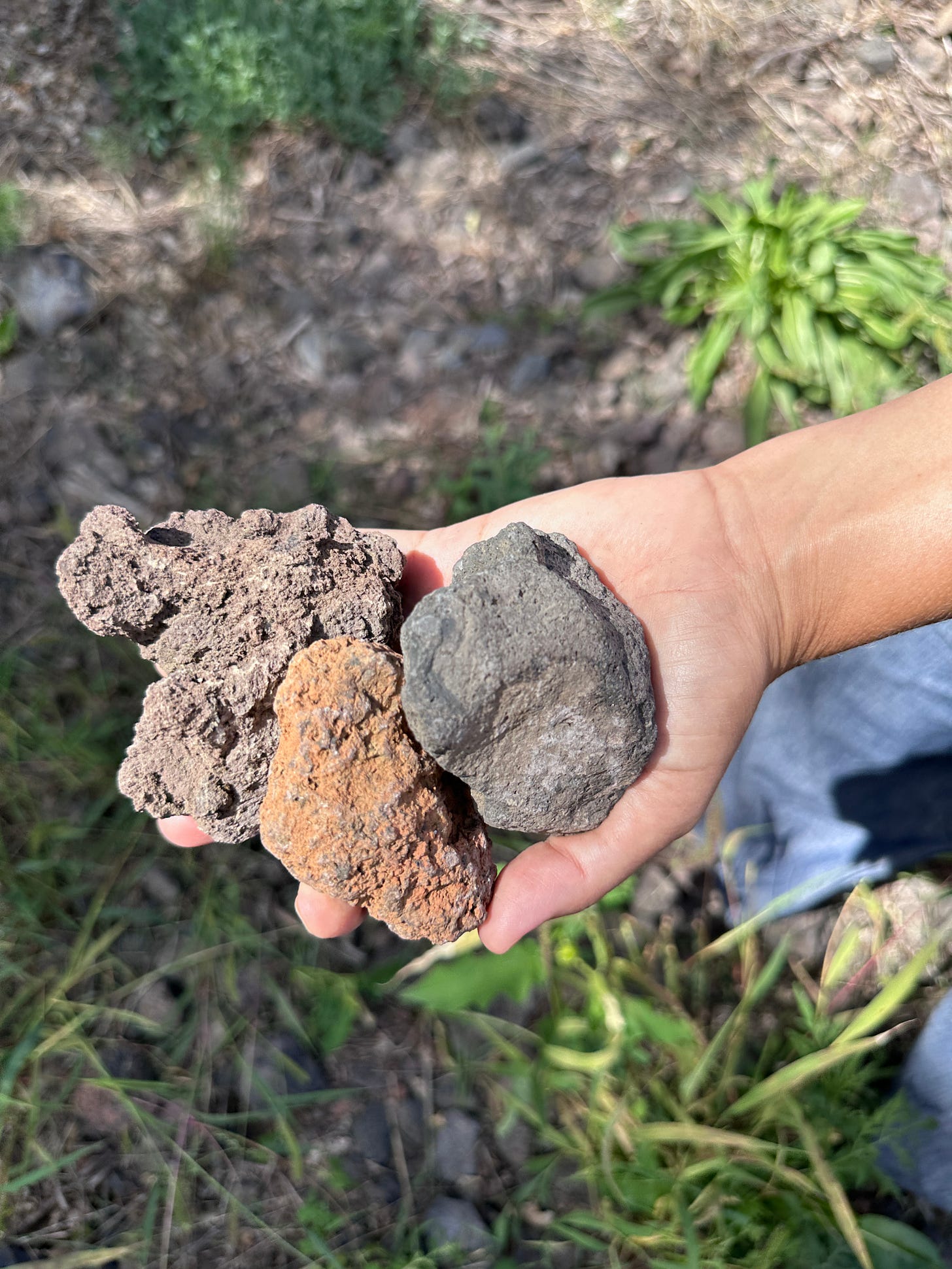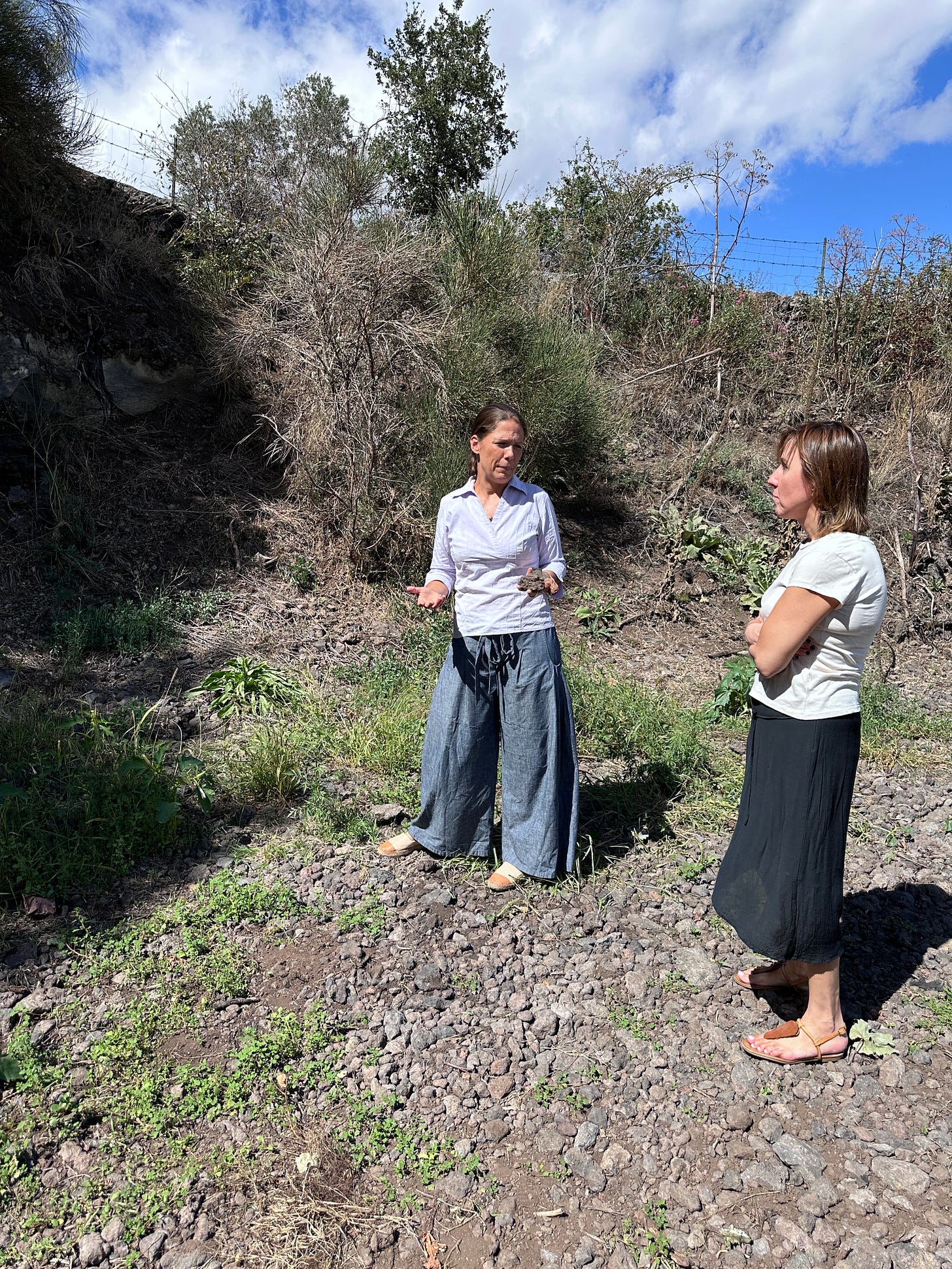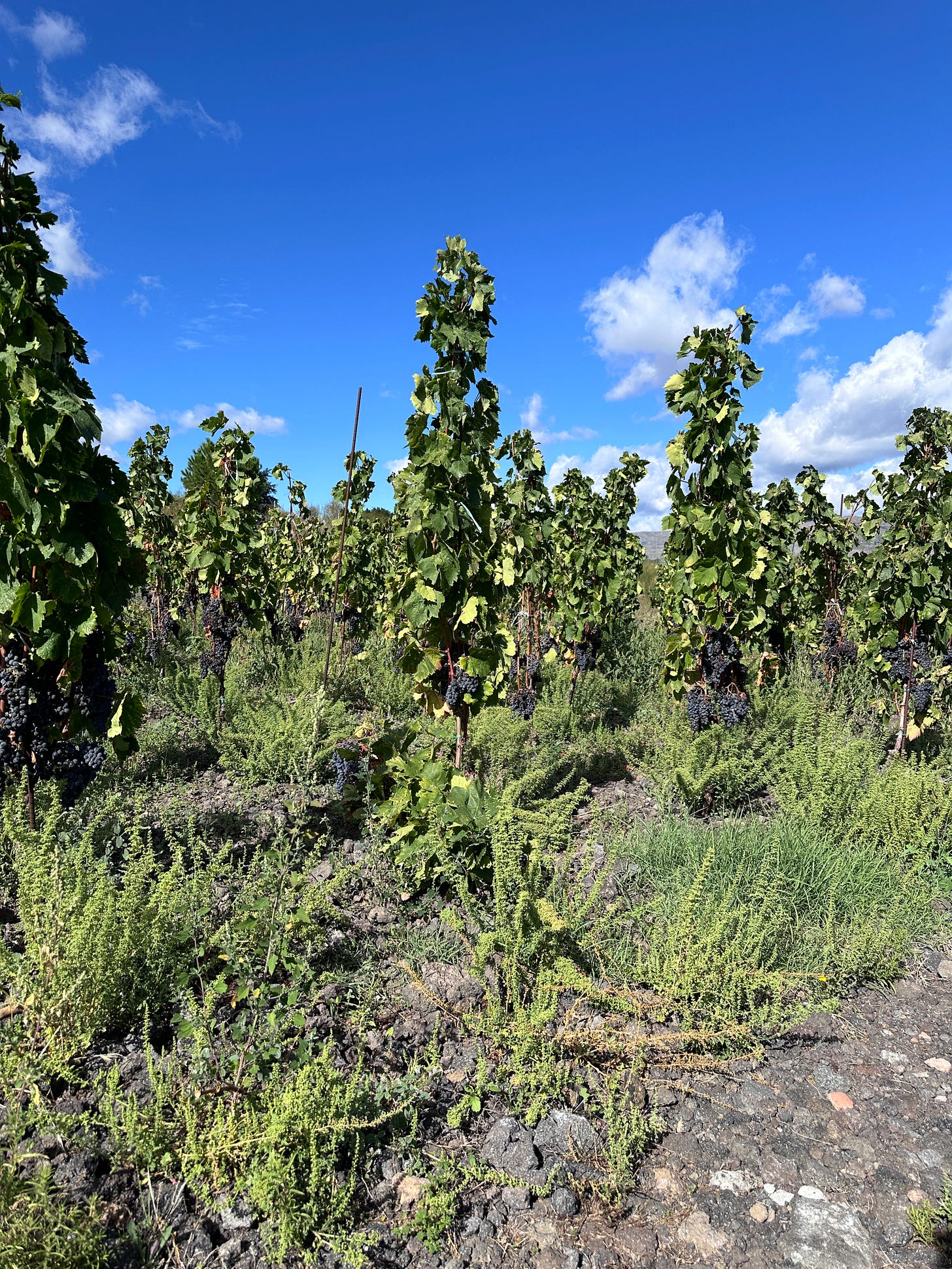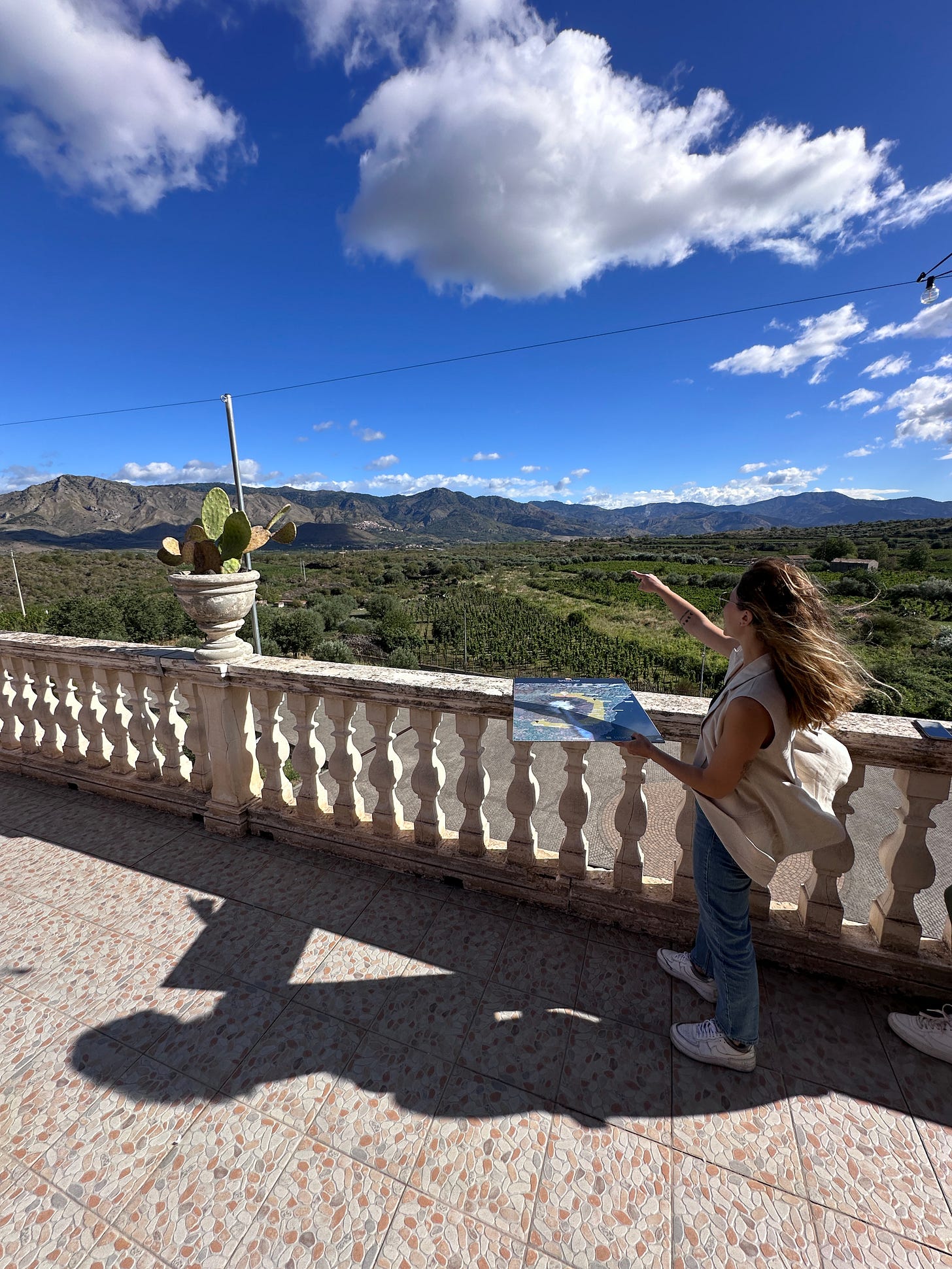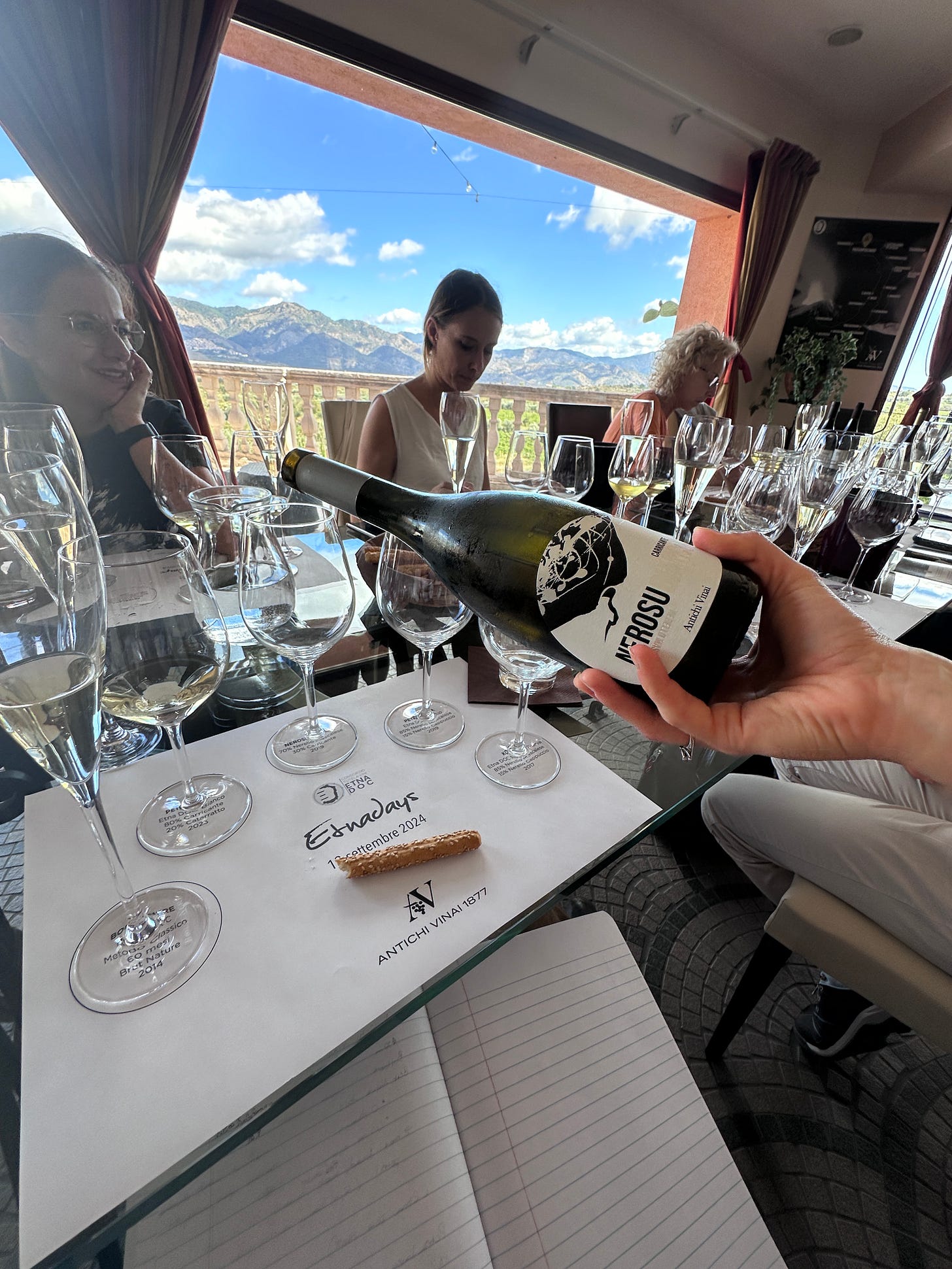Sciara: Land Over Time and Etna D.O.C Wine
A look at the words used to describe life and wine on Mount Etna provides a glimpse of how a region establishes its identity.
The winemakers of Mount Etna consider themselves a world away from the rest of Sicily, and that’s easy to understand after attempting to follow one of them down a slope in their vineyard, lava stones sliding under your feet, inviting you to play a game of “erosion” with them. The dried lava flow, called sciara (pronounced “sha-dah”), is everywhere: towering along roadsides, packed into vineyard floors, framing cellar doors—it’s the protagonist of Etna D.O.C., historically known for doubling as antagonist.
On Mt. Etna, wine is spoken of in terms of time as much as it is place; the active volcano is still shifting in shape and height today. When it last erupted and where the lava flowed have defined agriculture and life for centuries. On a trip to the Northern slope of the D.O.C., I followed Patricia Tóth and her brother through Planeta’s vines of Nerello Mascalese and Carricante as they told funny stories about their family, egging each other on. We walked down to the site where lava once flowed through the property in the eruption of 1614. That was the beginning of a ten-year-long eruption for the volcano, an era that has become a big part of the region's lore.
We stopped at an unassuming stone wall on the edge of their vineyard, and Tóth pointed to a red layer of soil running horizontally along the lower part of the wall. “Here was the original agricultural soil,” she said, then pointed to a vein of purple directly above it. “These were stuck in the lava, and got pushed down here from another area.” Eventually, plants and lichen dug into the wall and are still moving and shifting the earth. “This is still a very active slice of the eruption,” she said as a few rocks tumbled down behind her. Tóth remembered the first time someone pointed this portion of the wall out to her, teaching her how to track the timeline of soil and movement. “Do you know what this is?” he had asked her, to which she replied, “rocks?” and erupted in laughter.

Our day had started at another winery in the north, Antichi Vinai 1877. Squinting into the fierce Ionian wind, we passed rows of unbothered vines trained into freestanding mini-trees, an ancient training system known as albarello. Winemaker Viviana Gangemi told me that the term sciara is Sicilian, borrowed from the Arabic term, ‘Sahraa’—desert. Throughout antiquity, Sicily had been the target of conquest from a dizzying number of empires: the Phoenicians, Greeks, Romans, Goths, Byzantines, Arabs, Normans, Spanish Bourbons, French Angevin, and German Hohenstaufen have all been here at one point.
But most notably, after the fall of Rome, the island was under Islamic rule for almost two centuries. And while winemaking came to a halt during this time, grapes were cultivated for food, and innovative farming techniques from the Arab tradition made a permanent mark on agriculture, cuisine, and language throughout Sicily. “We call sciara what remains after a lava eruption,” said Gangemi. “Simplifying it is lava solidified: a large amount of lava basalt, lapilli, and ash”.
Sciara is completely infertile; grapevines can’t grow in it. “We would need to wait at least 400 years until the lava transforms itself into fertile terrain,” Gangemi told me. Her family’s vineyard is one of the first in the region—so old that the first few generations charged visitors by the hour rather than by the glass. But their site had been covered by the lava twice—once in 1614 and then again in 1879. Not willing to wait 400 years, they worked the soil from both eruptions to bring life to their vines. “First, we removed the 1879 lava, then we dug up the already fertile 1614 lava,” Gangemi told me. “Then we put down the stone from the 1879 lava for drainage and covered everything with a thick layer of the 1614 lavic soil.” Their last touch was to add organic fertilizer.
Mt. Etna is the largest volcano in Europe and the most active in the world—two weeks before I arrived, it had erupted quietly and unremarkably to locals. The island began as an underwater volcano 500,000 years ago, and as it erupted over time, it added layers, eventually emerging as an island in the Mediterranean Sea. Etna D.O.C. was the first delineated winemaking region in Sicily; it hugs the eastern, southern, and northern slopes of the volcano in a half-moon shape. Most of the vines are indigenous to the region and are grown to make high-acid, aromatic reds, whites, rosatos, and sparkling wines.
The white wines go by the name of Etna Bianco. Made from 100% Carricante (and sometimes a dash or two of local Catarratto), they have off-the-charts acidity, lemon, starfruit, apple, flowers, and a common saltiness. The rosatos, made from Nerello Mascalese, often have a spicy bite with roses, lavender, peach, apricot, and a wildness that feels innate, like the garrigue of the Rhone. Etna Rosso, the region’s red wine, is also made from Nerello Mascalese, sometimes blended with local Nerello Cappuccio. These wines are bright and earthy with cranberry, pomegranate, cola, date, black pepper, bark, and a minerality that I spent my entire three days there trying to describe.
For this aroma, I don’t think a descriptor exists. I haven’t encountered it outside the world of wine, and with no reference point, I found myself conjuring images of mythical monsters, sea creatures, and often, Hexxus from Fern Gully. Other times, it felt like a plume of volcanic ash rising from the glass. Is that from the sciara? The sea influence? The vines old enough to be my great-grandmother? Or all of the above? The mystery of minerality as an aroma is just that—a question for which we still don’t have all the answers.
After walking the steep Planeta vineyards, we shuffled over to their gazebo for a beautiful lunch of local sausage, onions, and provisions. Beside me sat Giusi Calcagno, a winemaker studying under her father and uncle, farming six hectares and naming their bottles after the flora and fauna that grow in the peculiar volcanic soil. Tastes of aromatic, mineral-y Calcagno bottles were poured alongside Planeta’s pops of citrus and earth as Calcagno showed me pictures of her life teaching Italian to Syrian refugees and carrying her family’s tradition into the new age of Sicilian winemaking.
In the early 20th century, a disease that was making its way throughout the world’s wine regions, phylloxera, arrived in Sicily. Two World Wars plunged the whole of Southern Italy into an economic crisis, and people abandoned their vineyards and left in search of work. As is often the case, at the end of the 20th century, a few charismatic winemakers returned to revive the tradition, and since then, many younger generations have returned, and the region has flourished again.
The second part of this story we know well: curious outsiders have started buying land as the new wave of winemaking has reached international waters. Speaking with Calcagno, I sensed a pride in existing at the convergence of many cultures as well as a resolve to protect the identity of Etna during this growth spurt. She told me more about the origins of sciara and other elements of Arabic influence that have found their rightful place in Sicilian life, like cinnamon saffron rice. “We have always accepted elements from other places, from ingredients to the workmanship,” she told me.
She listed other words rooted in the Arab tradition: the Alcantara, the river that extends between the cities of Messine and Catania, derives from al-qantar, which means bridge or arch. Etna is also known as Mongibello, from the Arabic word jebel: mountain. Zibibbo comes from zãbib, raisin. “Food is the real link with this culture because of its role in the construction and maintenance of identity,” Calcagno told me, “and for the fact that it allows us to understand the process of transformation and adaptation and the ability to integrate new experiences.”





